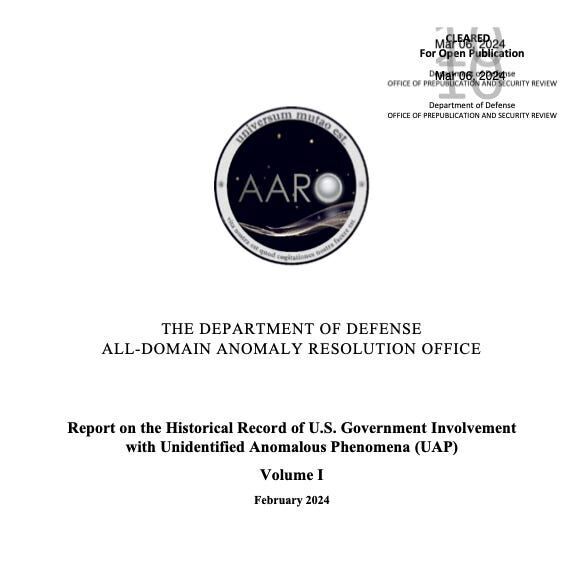Unfortunately, the report from the Pentagon's All-domain Anomaly Resolution Office (AARO) contains an array of striking omissions and one particularly egregious misrepresentation. The result is a misleading report which, like so much government UFO-related propaganda over seven decades, tells the reader just to move on, nothing to see here.
To start, it makes no mention of how the U.S. government's official investigation of UFOs began. In a landmark 1947 memo, Lt. Gen. (and future chairman of the Joint Chiefs of Staff) Nathan Twining stated that UFOs are "real and not visionary or fictitious." He also described their flight characteristics as including "extreme rates of climb, maneuverability...and action which must be considered evasive when sighted or contacted by friendly aircraft and radar."
Nor does AARO's report mention the earliest surviving intelligence assessment of UFOs — a late 1948 analysis that found many UFO reports came from observers "who, because of their technical background and experience, do not appear to be influenced by unfounded sensationalism nor inclined to report explainable phenomena as new types of aerial devices."
Citing reports from "trained and experienced U.S. Weather Bureau personnel" from early 1947, the omitted document noted multiple observations of "strange metallic disks" with "a flat bottom and a round top." (Note that these incidents predated by several months the widely-publicized June 1947 incident that catalyzed the "flying saucer" era.)
Other incidents involved "silver disks or balls" and "balls of fire" that stalked World War II aircrews over the European and Pacific theaters. The Associated Press, Reuters, New York Times, Newsweek, Stars and Stripes and the now-defunct International News Service referred contemporaneously to mysterious "silver colored spheres" and "silver balls which float in the air."
Although omitted by AARO, all of this historical background remains significant because, to this day, images and videos continue to emerge of objects fitting similar descriptions. In fact, AARO's ex-director openly stated as much during a May 2023 NASA presentation on UAP, that U.S. military personnel are observing "metallic orbs" "all over the world...making very interesting apparent maneuvers."
Moreover, AARO has not provided a plausible explanation for naval aviators' more recent encounters — including one harrowing near-collision — with spherical objects exhibiting extraordinary flight characteristics.
Worst of all, AARO's review misrepresents the most exhaustive, comprehensive historical analysis of UFO incidents, conducted on behalf of the Air Force by the Battelle Memorial Institute in the early 1950s. According to AARO, the resulting report found that "all cases that had enough data were resolved and explainable."
But this is not what Battelle's analysis found at all, and AARO's misrepresentation of its conclusions speaks volumes.
According to the Battelle analysis, as the quality of UFO reports improved, so too did the number with "unknown" explanations. Of the UFO cases considered "Excellent" and with sufficient data to draw a conclusion, 33 percent were categorized as having "unknown" origin.
Lastly, AARO states that it found no "empirical evidence...that the [U.S. government] and private companies have been reverse-engineering extraterrestrial technology." But the report's categorical denials, alongside recent commentary from AARO's former director, place the agency in an awkward position. Christopher Mellon, the Pentagon's former top civilian intelligence official, recently stated that key UAP whistleblowers did not trust AARO and went instead to Congress or the inspector general of the intelligence community.
AARO appears to have conducted little investigation beyond superficial interviews, whereas the intelligence community inspector general is a law enforcement official with formal investigative authorities.
The result is a remarkable disconnect between AARO's report and what members of Congress revealed after the inspector general briefed them in January. Following the classified briefing of a bipartisan group of 16 members, five were quoted saying they found UAP whistleblower David Grusch or his allegations to be "credible," "legit," or to have "merit." Several members noted that the briefing gave them insights into specific locations and private defense contractors, seemingly aligning with Grusch's claims.
Such reactions, in tandem with the inspector general's ongoing, two-year investigation of Grusch's complaint, seem incongruous with AARO's conclusion.
The inspector general found Grusch's allegation that "information was inappropriately concealed from Congress" to be "credible and urgent." Sen. Marco Rubio (R-Fla.), vice chairman of the Senate Intelligence Committee, has since corroborated this finding.
Senate Majority Leader Chuck Schumer (D-N.Y.), along with a bipartisan group of five other senators, sponsored extraordinary legislation largely mirroring Grusch's shocking allegations. In extraordinary comments on the Senate floor, Schumer stated that, according to "multiple credible sources," elements of the U.S. government have been withholding UFO-related information from Congress illegally.
Despite AARO's former director repeatedly characterizing allegations of illicit UFO retrieval and reverse-engineering efforts as baseless, the principal cosponsor of Schumer's UAP Disclosure Act, Sen. Mike Rounds (R-S.D.), indicated last week that the Senate will proceed with the legislation.
In short, there seems to be a classic conflict of interest in the executive branch investigating itself. Congress, a coequal branch of government does not suffer from this. And so in the wake of AARO's flawed report, a congressional select UAP committee, like the one requested by Rep. Eric Burlison (R-Mo.), should step forward to separate fact from fiction.
Marik von Rennenkampff served as an analyst with the U.S. Department of State's Bureau of International Security and Nonproliferation, as well as an Obama administration appointee at the U.S. Department of Defense.




The people in the SAPs will tell congress to go fuck itself. The information is much too valuable and/or critical for security to allow a bunch of corrupt political hacks to have access to it. - What? You think Hillary or Pelosi or others in that cesspool should have access to a deep black program??